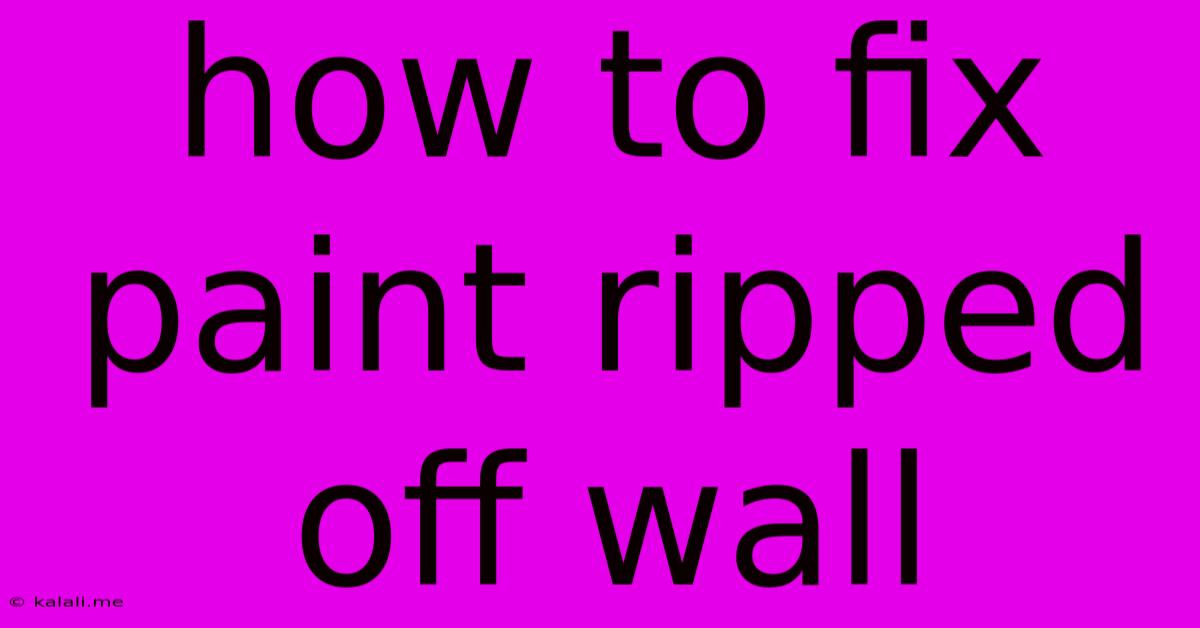How To Fix Paint Ripped Off Wall
Kalali
May 24, 2025 · 3 min read

Table of Contents
How to Fix Ripped Paint on Your Wall: A Step-by-Step Guide
Dealing with a section of paint ripped off your wall can be frustrating, but it's a common problem with a relatively simple fix. This guide provides a comprehensive, step-by-step approach to repairing ripped paint, ensuring a seamless and professional finish. Whether it's a small chip or a larger area, this guide covers everything you need to know, from assessing the damage to achieving a flawless repair.
What You'll Need:
- Putty knife: For cleaning up loose paint and applying patching compound.
- Sandpaper: Different grits (e.g., 120, 220) for smoothing surfaces.
- Patching compound: Choose a compound suitable for your wall type (e.g., drywall, plaster).
- Primer: To prepare the repaired area for painting.
- Paint: Matching your existing wall color.
- Paintbrush or roller: For applying primer and paint.
- Drop cloth or plastic sheeting: To protect your floor and surrounding areas.
- Masking tape (optional): To create clean edges.
- Sponges or damp cloths: For cleaning up excess compound.
Step-by-Step Repair Process:
1. Assess the Damage & Prepare the Area
Before you begin, determine the extent of the damage. A small chip requires a different approach than a large, ripped section. Carefully remove any loose paint fragments using a putty knife. Clean the area thoroughly to remove dust and debris. Protect the surrounding area with a drop cloth.
2. Apply Patching Compound
Using a putty knife, carefully apply the patching compound to the damaged area. For small chips, a small amount is sufficient. For larger rips, apply the compound slightly beyond the damaged area, building up layers if necessary to fill the gap completely. Allow the compound to dry completely according to the manufacturer's instructions.
3. Sand the Repaired Area
Once the patching compound is dry, use sandpaper (starting with a coarser grit like 120, then moving to finer grit like 220) to smooth the repaired area until it is flush with the surrounding wall. Be gentle to avoid creating new imperfections. Remove any dust with a damp cloth.
4. Prime the Repaired Area
Applying primer is crucial for ensuring the paint adheres properly. Use a small paintbrush or roller to apply a thin, even coat of primer to the repaired area. Allow the primer to dry completely.
5. Paint the Repaired Area
Once the primer is dry, carefully apply paint matching your wall color. Use a small paintbrush or roller, ensuring you blend the new paint seamlessly with the existing paint. Apply multiple thin coats rather than one thick coat for a smoother, more even finish.
6. Final Touches & Clean Up
Allow the paint to dry completely. If necessary, lightly sand the area again with very fine-grit sandpaper to smooth any imperfections. Clean up any excess paint or dust. Step back and admire your handiwork! You've successfully repaired the ripped paint on your wall.
Tips for a Professional Finish:
- Choose the right patching compound: Selecting a compound appropriate for your wall type is essential for a long-lasting repair.
- Sanding is key: Careful sanding ensures a smooth, even surface for painting.
- Thin coats are better: Applying multiple thin coats of paint prevents brush strokes and ensures even coverage.
- Blending is crucial: Blend the new paint seamlessly with the existing paint to avoid noticeable patches.
By following these steps, you can easily repair ripped paint on your wall, restoring its appearance and saving money on professional repairs. Remember, patience and attention to detail are key to achieving a flawless finish. Now you can enjoy your beautifully repaired wall!
Latest Posts
Latest Posts
-
Hamilton Beach Rice Maker Weird Taste
May 24, 2025
-
Logrotate Failed Sqlnet Log Failed Permission Denied Selinux Oracle Logs
May 24, 2025
-
Should There Be A Space After Footnotes
May 24, 2025
-
How Big Should Margins Be On Your Website
May 24, 2025
-
How To Fix Rough Idle When Ac Is On
May 24, 2025
Related Post
Thank you for visiting our website which covers about How To Fix Paint Ripped Off Wall . We hope the information provided has been useful to you. Feel free to contact us if you have any questions or need further assistance. See you next time and don't miss to bookmark.